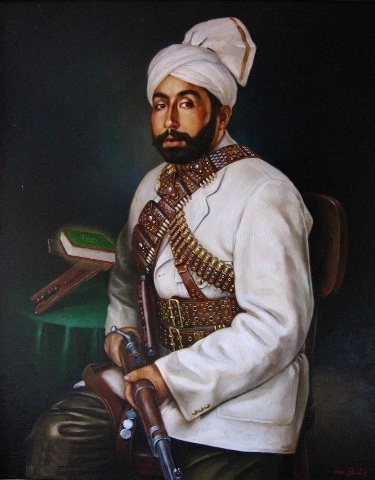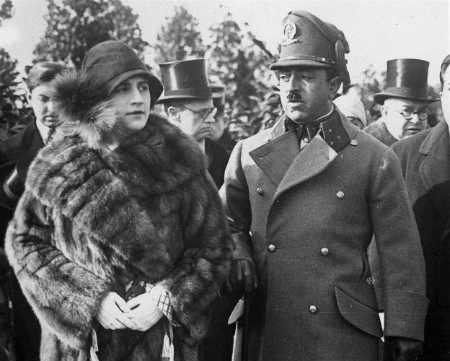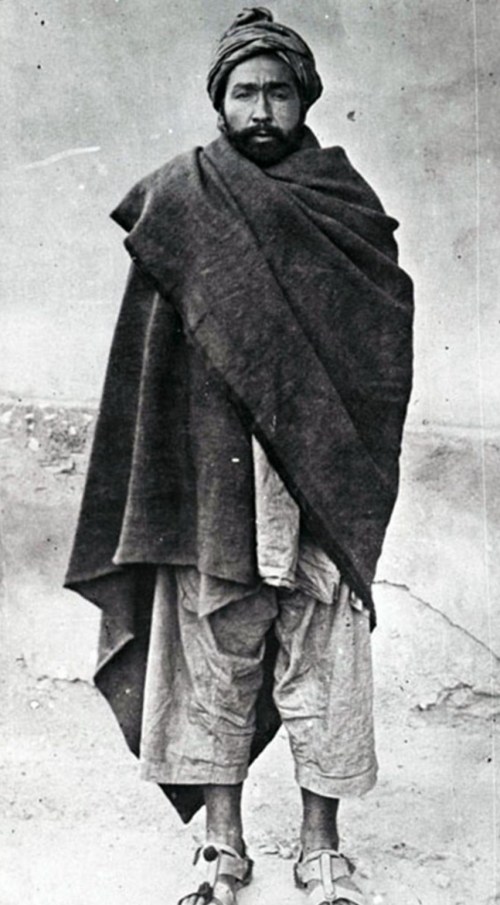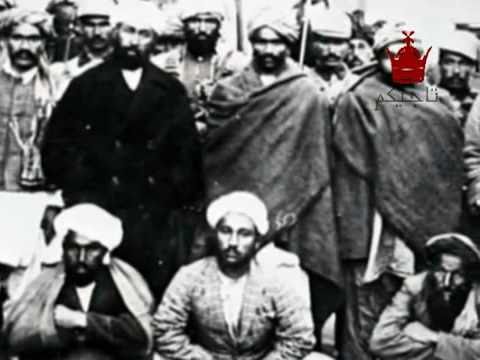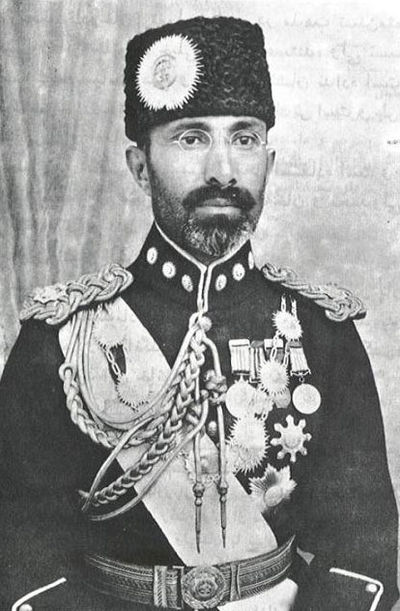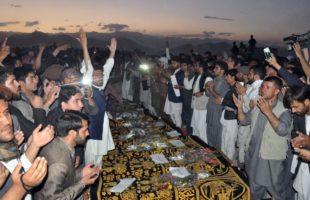Bacha Saqa Water Carrier and Servant of King Aman ullah Khan , who became the King of Afghanistan
Habibullah Kalakani/ BACHA SAQA (Dari: حبیبالله کلکانی), (19 January 1891 – 1 November 1929), was a King of Afghanistan who ruled from 17 January 1929[note 1] to 13 October 1929. He was an ethnic Tajik. He was named ( Habibullah Bacha Saqa or the Water Carrier ).
During the Afghan Civil War (1928–1929), he Forcefully occupied the Afghan throne by Replacing King Amir Ghazi Amanullah Khan Durrani.[4]
He was Replaced by and Assassinated by General of King Amir Ghazi Amanullah Khan Durrani. as Mohammed Nadir Shah, Later Proclaimed as King of Afghanistan in Absence of King Amir Ghazi Amanullah Khan Durrani
Who had Proclaimed Asylum in Italy in Europe after British Helped him Escape to Europe via Karachi Port , while He escaped from Afghanistan Leaving the Throne to His Brother Amir Enayat Ullah Khan Durrani.
Habibullah Kalakani was born in either 1891[6] or 1870[7] in the village of Kalakan,[8] north of Kabul. He was an Ethnic Tajik. In his memoirs, Kalakani stated that his home village was “miserable” and that he had “conceived a deep hatred of its poverty-stricken exterior”.[9]
Service with Durrani King Amanullah Khan in Army
At age 14, he left for Kabul on horseback with his friends Nur and Jamal.[9] Later, he joined King Amanullah Khan’s army, and fought in the Third Anglo-Afghan War
During the latter war, he served as officer with the Royal Army‘s “Model Battalion” and served with distinction during the suppression of the insurgents.[10]
The young man joined the army and, according to Leon Poullada (see FN 3), served in a model unit under the command of Turkish officers which had been called into the country under Afghan ing Amir Ghazi Amanullah Khan Durrani , father, Amir Habibullah .
After Amanullah took over the throne in 1919 due to his father’s assassination, Durrani King Amer Habibullah-1 fought in the short Third Anglo-Afghan War in that same year. Ironically, this was under the command of General Muhammad Nader Khan.
Joining British Sponsored Afghan Civil War with Mangal Revolt organised by the British
Nevertheless, Bacha Saqa , deserted the unit at some unspecified time from Army of Durrani King Aman Ullah Khan , during the and the Khost rebellion of 1924 Against the Modernizing Campaign of Durrani King Amanulah Khan ,
In 1924, Bacha Saqa , is said to have joined the Mangal uprising in the Khost area, led by a Mullah Abdullah, better known as Mulla Lang (the Lame Mulla).
According to Afghan historian Nazif Shahrani the uprising was triggered by a dispute over a child marriage, which Amanullah had abolished.
The uprising was suppressed in January 1925 and Mulla Lang was captured and executed in Kabul.
Over the course of the Rebellion, which Fayz Muhammad described as being suppressed “only with great difficulty”,[18] 14,000 people had Died [13] and the Afghan government lost £5 million in state revenue.[7] Although unsuccessful, it succeeded in delaying many of the king’s reforms until 1928.[10]
The defeat of the Khost rebellion was followed by reprisals on the Mangal population. 1515 men were executed, 600 women were dragged off to Kabul, and 3000 houses were burnt and razed to the ground.[14] In the central square of Kabul,[30] the “Khost Monument” [30]was built, celebrating the “Triumph of knowledge over ignorance”.[23]
Deserter and Petty Thief and a Bandit Criminal and Murderer
Bacha Saqa , After Deserting , For three years, they lived in mountain caves, venturing out during the day to rob and hiding out at night, all the time fearful of government retaliation. .[11]
Thereafter, Kalakani Bacha Saqa began a life of Banditry, since he considered the occupations common among the Koh damanis, like viticulture and selling firewood, to be beneath him, reasoning that these could hardly ever provide wheat bread for his table. Instead, he began to rob caravans and nearby villages.
He was joined by Sayyid Husayn and Malik Muhsin, as well as others, totaling 24 in all. and then moved to Parachinar Khyber Pakhtunkhwa (on the Afghan border) where he was arrested and sentenced to eleven months imprisonment for Criminal Activities as Petty Thief and Banditory after he and his Accomplices were Caught .[11]
Other Afghan reports say that he was involved in Robbery and Murders did some jail time in Parachinar and Peshawar Jail in British India. but the British Intelligence Agencies recruited him and Trained and sent him to Afghanistan in 1928 to Topple King Aman Ullah Khan from Peshawar.
In Peshawar Bacha Saqa spent some years said to have worked in a tea house (although other sources say he owned it) and British Paid him , for all his Services.
Taliban Proto Type as Wahabist used against Progressive King Amanullah of Afghanistan to Safeguard British Raj.
In 1928, he returned to Afghanistan with Support of British Raj and its Secret Services , Bacha Saqaa / Kalakani and his bandit group also murdered Ghulam Ghaus Khan, Governor of Charikar.[11]
From Jail the British Secret Service Picked him up for the Taliban Like Plans of Causing trouble for Durani empire King Ghazi Aman Ullah Khan who had been Fighting the British in Third Anglo-Afghan War , and the Afghan King wanted the Peshawar and also the Areas that now constitute Pakistan and Especially the provinces of Khyber Pakhtunkhwa , Baluchistan and Gilgit and Baltistan Part of Kashmir Area that belonged to Afghanistan before the Durrand Line .
The Afghan Durrani Empire King Amanullah Khan. , was Looking Towards the European Power of Germany and the Ottomans Caliphate of Turkey ( now Broken up after Word war -1 , and was Disillusioned with the British Empire who had been Chalking the Durrand Line and also Was trying to Enforce it as Border and Durrani King Amanullah Khan. was not Happy with it . Although he had been Neutral in Word War -1 and that was his Mistake .
The Quit Indian Movement and Civil Disobedience movement of Indian under Gandhi and Chandhra Bose had been not allowed from Peshawar to Kabul and also He did not Side with Rebellion although there was report of him Promising to help that and that was Trouble for British who were Afraid of Germany and Japan to come through Afghanistan to India and so was Chance of Soviet Union Russia Invasion .
Durrani King Amanullah Khan. was big Threat to British Raj and he was not Agreed to Durrand Line . and also Wanted his Areas back as they still considered the area now in Pakistan as their own up to Delhi as Afghania Province ( one of 12 in 1857 Attock is a Miss conception Afghania was up to Delhi )
At That time Quit India Movement and Civil Disobedience movement of Congress , and Indian Freedom Fighters Army under Chandra Bose movements were in Full Swing and many People were Operating from Afghanistan using it as a Platform Against British Raj and this was not Acceptable to British Raj , so they Decided to Conspire Against the King of Afghanistan .
Revolt on British Side of Durrand line FATA Tribal,s using Wahabi Deobandi Movement as Spies .
The British , with their Allies the Wahabist Mullahs of Deoband who were on their Pay role , via the Paid Agents as the Sahibzada and Khan Bahudurs and Arabs Maliks and Khan on their Pay role and big Pensions and Bursaries , employed the Wahabist Mullah Full time .
As a Result the Created a Revolt on basis of Bidat / Pakism ( Purity ) / Wahabist Principals Against the Durrani King Amanullah Khan. of Indian Sub Continent 1757 -1857 to Weaken them and Enclose them in Afghanistan Area and then also further Weaken them by using the Tribals of FATA who were on the British side of Durand Line ( Now Pakistan ) .
In Peshawar the Madrissahs of Deobandi wahabists was used according to Secret Reports of Durani King Amanullah Khan. and he also caught many Spies Red Handed , include one of British Origin in Around Kabul .
The British spy caught in Kabul on Beating told him about the role of Famous Spy Lawrence of Arabia Stationed as a Air force Mechanic in Waziristan , who being a colonel in British Intelligence was stationed in Wanna in Waziristan .

British Raj Spy Lawrence of Arabia in Waziristan Wana Airport in Waziristan Miranshaw as Airforce Mechanic -1928
The Lawrence of Arabia was a Special Spy pf Great Game , and he was the one who had destroyed the Muslim Ottomans Empire and established the Saudia Arabia and was one of the Gang of Abdullah Harry Philby and his Son Kim Philby .
Lawrence of Arabia was Master of Wahabism and using the All Saudi Family in Divide and Rule .
The King Wrote and Article in the British Newspaper from his own pen about the Celebrity Spy Lawrence of Arabia and it exposed his cover .
Using FATA Tribal from Pakhtunkhwa to Cause Overthrow of Kabul Durrani Empire using Wahabi Deoband
Lawrence of Arabia was Immediately called to Britain , after that but he has done his job via the Wahabist against Durani King Amanullah Khan of Afghanistan using the Tribal,s of Khyber Pakhtunkhwa
The British Trained Bacha Saqa in Wahabized Deobandi Islam in Peshawar area and he was Provided Arms and Ammunition and training to Subvert the Government of Ghazi King Aman ullah Khan .
The Experiment of using Deobandi Wahabi Islam to Discredit a Progressive Nationalistic Ruler like Durani King Ghazi Aman Ullah who just a Years back had Fought the Third Anglo Afghan War with the British , is an Example of Taliban Like activity in Past .
The Modern Day Taliban are Actually a Photo Copy of Bacha Saqa Plan of using the Wahabist Ideology against Modernization and turning Afghans and Pashtons into a Saudi Arab like Backward and Fanatical Wahabist / Salafist Ideology that can Molded easily as Secret Army for the British using Fake Islam .
The Current New Great Game is also an Example of History Repeats Itself and Bacha Saqa Story is a Point in that .
The British through their Political Agents , used the Waziristan Tribes and that of Shinwari and Afridi Tribes of Khyber Agency in Khyber Pakhtunkhwa to cause a Revolt against the King of Afghanistan who tried to Modernize Afghanistan as his wife family and the King wanted to Educate and Modernize Afghanistan ,
but the Wahbized Deobandi Mullahs who were bought by the British and were there Paid agents , they did Propaganda against Durani King Ghazi Amanullah Khan and Mislead the Tribal of Khyber Pakhtunkhwa
As a result , the Back ward tribes of FATA in Khyber Pakhtunkhwa those who were in British ( Now Pakistan ) side of Durand Line , revolted initially Against Kabul , and Bacha Saqa , also joined them .
Wahhabi King Bacha Saqa of Afghanistan , is very Interesting Example of what was to follow later as Taliban and Al-Qaeda / ISIS and similar poor Bandits and Criminal war lords continue to Rule Afghanistan and they want to be Bach Saqa Like Saqwites
While the Afghan National Army was engulfed in battle with Pashtun outlaw tribes in Laghman and Nangarhar Near Peshawar in the east of the country,
the Bacha Saqqawists, led by Kalakani began to attack the unprotected Kabul from the north in 1928 and tried to Kill the King and they carried out Wahabist style Beheading of who ever they found and this Terrified the People
The revolt caught steam and the country was thrown into a civil war.
Wild tribesmen Khyber Pakhtunkhwa from Waziristan and khybber Agency the shinwaris and Afridis under the control of British Raj paid Political Agents and Paid Maliks and lungi Holders as Khan Bahdurs and Arbabs , as they are called.
some were also the Trained FC Frontier corps Soldiers and officers in Disguise . they had the southern areas of Kabul surrounded, and Kalakāni’s forces were moving into the heart of Kabul from the north.
Escape of Durrani King in Mercedes Car Gifted by Germans after he was Heart broken and wowed never to Return
In the middle of the night, on 14 January 1929, Durani King Amanullah Khan. handed over his kingdom to his brother Inayatullah Khan and escaped from Kabul towards Kandahar in the south, in his Mercedes Car Presented by the Germans that out ran the Horses of Bacha Saqqawists,following him ,
Two days later, on 16 January 1929, Bacha Saqa / Habib Ullah Kalkani wrote a letter to King Inayatullah Khan Durrani brother of Ghazi Amir Aman Ullah Khan to either surrender or prepare to fight.
Inayatullah Khan responded by explaining that he never wished to become king, and agreed to abdicate.
Reign of Bacha Saqa Over Afghanistan had begun on Afghanistan via Fraud and Fake Islam of Deoband Wahabist and the British has achieved what they never could have Dreamt of and without a Single Drop of Blood .
Taliban Like Rule on Afghanistan
The new king ruled as Habibullah II. / Bacha Saqa , With this name, he puts himself in line with Amanullah’s father, the murdered Amir Habibullah – or Habibullah I – in a side-blow at Amanullah,as some sources suspect that Amanullah supporters were behind the assassination of Habib Ullah -1 father of Amanullah Khan (10)
When in power, Habibullah II / Bcha Saqa , immediately revoked Durani King Amanullah’s progressive reforms. (11)
He made Sharia the only law of the land, ordered that men should not shave and should wear the turban again, and women the hijab (under Amanullah this had been banned for government officials’ wives).
He decreed that women should not to leave the house without a mahram, male Guardian
He was enemy of Education and was Illiterate Damn Fool himself , Closed girls (and many Male ) schools and banned the teaching of “kafir languages” ( European ) to Muslim children (these rules are quoted from his newspaper Habib ul-Islam, here).
He also called home the first group of Afghan female students who had been sent to Ottoman Muslim Caliphate of Turkey.
He abolished the ministries of education and justice because, US historian Vartan Gregorian writes, he considered them unnecessary and an infringement of the authorities of the clergy.
His fighters had free reign to loot and kill, and Behead and even in the foreword of his ‘autobiography,’ his rule is referred to as the “Reign of Terror.”
Some authors call Bacha Saqa a “fundamentalist” for his anti-reform course. French author Olivier Roy, for instance, in his standard work Islam and Resistance in Afghanistan (1990), calls him the “candidate of a fundamentalist coalition,” because Pashtons non-Tajik ‘tribes’ and wide segments of the Islamic clergy supported him (or, more precisely, opposed Amanullah).
Gregorian writes that Bacha Saqaa saw himself as a representative of the “True faith,” / Bidat / Pakism / Purity / Wahabism / Salfism, considered all the Rest as Kafirs / Unbelievers .
This assessment was shared by a number of Afghans when the issue of reburial came up recently; they accused Bacha Saqaa of ‘Talebanish’ policies.
Guerrilla Taliban Ware fare against Incursion into Russian USSR for His masters the British Raj.
Being a British spy Bacha Saqa was Obliged to the British and he allowed the Gueralla Warfare Against Russian Empire from Afghanistan that was Against the Treaty of Gulistan inked between Russia and British Raj and maintgain the Neutrality of Afghanistan as Buffer Zone as Maintained by the Durrani Empire Kings.
During this period anti-SRussia rebels from Central Asia known as Basmachi utilized the period of instability in Afghanistan to launch raids into the Soviet Union. The Basmachi had taken refuge in Afghanistan earlier in the decade after they were expelled from Soviet Central Asia by the Soviet military and they swore allegiance to the Emir of Bukhara, who lived in exile in Kabul. One of these raids was led by Faizal Maksum, who operated under the command of Basmachi commander Ibrahim Bek. Faizal Maksum’s forces briefly captured the town of Gharm until they were expelled by Soviet forces.[12][13]
Basmachi leaders were in Afghanistan as they had been viciously pursued by Soviet troops. These included Ibrahim Bek, an Uzbek from eastern Bukhara, who had come in 1926 and the Turkmen Junaid Khan who had crossed over in 1928 and was now living in Herat.
Both declared their support for Bacha Saqa and supported him with fighters. But, they also profited from Bacha Saqa’s support and were able to invigorate their rebellion on Soviet territory (see, for example, this 27 May 1929 Chicago Tribune report).
Suppression of Loyal Afghan Hazaras by Bacha Saqaa and Bismachis Uzbeks /Tajiks in Afghanistan
In Afghanistan, Bacha Saqa sent Ibrahim’s men to fight the Hazaras who still supported Amanullah, mainly because his 1919 decree abolishing slavery in 1919 had particularly improved their lives (see here).
When, in 1929, Muhamamd Nadir shah Foces and with Amanullah supporters and marched into Northern Afghanistan and took Mazar with Soviet support, 900 of Ibrahim Beg’s and Junaid Khan’s fighters were mobilised to bolster Bacha Saqa deputy and minister of war, Sayyed Hossain (who was executed with him later).
In the last days of Bacha Saqa nine-month reign, Boyko writes, Basmachi commander Ibrahim Bek of Bukhara functioned as a quasi-chief of the garrison in Khanabad (in today’s Kunduz province), then capital of Qataghan province.
The Basmachi operated in Afghanistan due to their alliance with Bacha Saqa and after his fall from power they were expelled from Afghanistan.[14]
Return of Pashton Durani Empire as General Nadir Shah form Durrani Empire
The powerful Pashtun tribes, including the Ghilzai, of Khyber Pakhtunkhwa who had initially supported him against Amanullah, chafed under rule by a non-Pashtun. a tajik / Uzbel and aslo a Bandit and a Criminal and petty thief and with Taliban Like Activity .
The five prominent Durrani Musahiban brothers included Nadir Shah, the eldest, who had been Amānullāh’s minister of war and he was under training in Dera Doon in India in Modern Ware fare under the British.
General Nadir Shah came to rescue of Afghanistan , and he brought some Army , They were permitted to cross through the Khyber Pakhtunkhwa to enter Afghanistan and take up arms.
Once on the other side of Durrand Line .in Afghanistan , however, they were not allowed back and forth across the Durrand Line .to use British-Indian territory as a sanctuary, nor were they allowed to gather together a tribal army on the British side of the Durrand Line .,
but many Pashtons were angry about Tajik / Uzbek Bacha Saqa being a King as they were slaves in Pashton King ships till Father of King , Durani King Habib Ur Rahman.
But his son Durrani Empire King Amanullah Khanreign, Uzbeks /Tajiks and Hazara were Released from Slavery .
However, the Durani Musahiban from brothers After several unsuccessful attempts, Nadir and his brothers finally raised a sufficiently large force—mostly from the British side of the Durand Line in current the Khyber Pakhtunkhwa—to take Kabul on 13 October 1929.[15]
Durrani Musahiban brothers as General Nadir Shah were also from Royal Family and They were also from the Durrani Yousafzai Main Clan of Pashotns as Sub Branches Mohammedzai and Barakzai Sub family trees, that Made the Durrani Empire of Indian subcontinent 1757- 1979 , and whose great-grandfather was an older brother of Dost Mohammad.
General Nadir Shah Proclaimed himself the Durrani King of Afghanistan Finally , with help of Tribes of pashtons on Both side of Durrand Line .
Bach Saqa Grave discovered in 2016 and Death in 1929 and Controversy .
Durrani King Nadir Shah considered pardoning Bacha Saqa , but pressure from loyal Pashton tribes on both sides of Durrandi line led him to executed in Front of Kabul crowed by hanging the Bacha Saqa Habib ullah Kalakani on 1 November 1929.[15]
His remains were laid below a hilltop mausoleum at an undisclosed location for 87 years, until a campaign in 2016 by some Tajiks and scholars who wanted him to be reburied in a better place.[16]
This caused days of political and slight sectarian tensions in Kabul – Tajiks and religious scholars, who consider Bacha Saqa to have been a devout Muslim, wanted him to be buried at the Shahrara hill and asked President Ashraf Ghani to plan a state burial.
Opponents to Kalakani, mostly Pashtuns and some Uzbeks and tajik Secularists , were against this plan, including vice-president Abdul Rashid Dostum who claimed that he could not be buried at a hilltop important to Uzbek heritage.[17]
He was eventually buried at the hill on September 2, with four injuries and one death in clashes between his supporters and pro-Dostum soldiers.[18]
The scuffles around Bacha Saqa remains and his reburial , not long after Afghanistan’s independence day attributed to Father of Afghan Nation King Amanullah who, as a result of the short Third Anglo-Afghan War in 1919, had returned the country to full independence.
The war resulted in the Anglo-Afghan Treaty of Rawalpindi, which was concluded on 19 August 1919 and has since been celebrated as the country’s independence day.
But not everyone shares the narrative of the reformer versus the anti-reformer. especially the Talibanish Characters ( CIA Operations Cyclone By Products ) of Afghanistan , like Hashmat Mosleh, a former advisor to Taliban President Burhanuddin Rabbani, juxtaposes Bacha Saqa Wahabist ’s religiously motivated resistance against Durrani King Amanullah’s secular, Westernising modernisation. In a recent op-ed for the al-Jazeera website,
References
- Habibulah, Amir (April 1990). My Life: From Brigand to King. Octagon Press. ISBN 9780863040474. – An autobiography of Habibullah Kalakani.
- Qassem, Dr Ahmad Shayeq (2013-03-28). Afghanistan’s Political Stability: A Dream Unrealised. Ashgate Publishing, Ltd. p. 175. ISBN 9781409499428.
- ^ Wazir, Azmatullah Khan (2002). The immediate solution of Afghan crisis. A.K. Wazir. p. 8.
- ^ Muḥammad, Fayz̤; McChesney, R. D. (1999). Kabul under siege: Fayz Muhammad’s account of the 1929 Uprising. Markus Wiener Publishers. p. 37. ISBN 9781558761544.
- ^ Jump up to:a b Muḥammad, Fayz̤; Hazārah, Fayz̤ Muḥammad Kātib (1999). Kabul Under Siege: Fayz Muhammad’s Account of the 1929 Uprising. Markus Wiener Publishers. ISBN 9781558761551.
- ^ Adamec, Ludwig W. (2011). Historical Dictionary of Afghanistan. Scarecrow Press. p. 183. ISBN 0-8108-7957-3. Retrieved 2012-08-28.
- ^ Lansford, Tom (2017-02-16). Afghanistan at War: From the 18th-Century Durrani Dynasty to the 21st Century. ABC-CLIO. p. 235. ISBN 9781598847604.
- ^ “BAČČA-YE SAQQĀ – Encyclopaedia Iranica”. http://www.iranicaonline.org. Retrieved 2019-09-13.
- ^ Muḥammad, Fayz̤; McChesney, R. D. (1999). Kabul under siege: Fayz Muhammad’s account of the 1929 Uprising. Markus Wiener Publishers. p. 1. ISBN 9781558761544.
- ^ Jump up to:a b Kalakāni, Habibullāh (1990). “Chapter 1 – A village in Kohistan”. My Life: from Brigand to King: Autobiography of Amir Habibullah. Octagon Press. ISBN 9780863040474.
- ^ Shahrani, M. Nazif (1986). “State Building and Social Fragmentation in Afghanistan: A Social Perspective”. In Ali Banuazizi; Myron Weiner (eds.). The State, Religion, and Ethnic Politics: Afghanistan, Iran, and Pakistan. Syracuse, New York: Syracuse University Press. p. 57.
- ^ Jump up to:a b c Muḥammad, Fayz̤; Hazārah, Fayz̤ Muḥammad Kātib (1999). Kabul Under Siege: Fayz Muhammad’s Account of the 1929 Uprising. Markus Wiener Publishers. p. 32. ISBN 9781558761551.
- ^ Ritter, William S (1990). “Revolt in the Mountains: Fuzail Maksum and the Occupation of Garm, Spring 1929”. Journal of Contemporary History. 25: 547. doi:10.1177/002200949002500408.
- ^ Ritter, William S (1985). “The Final Phase in the Liquidation of Anti-Soviet Resistance in Tadzhikistan: Ibrahim Bek and the Basmachi, 1924-31”. Soviet Studies. 37 (4). doi:10.1080/09668138508411604.
- ^ Fayz Muhammad, R. D. McChesney. Kabul Under Siege: Fayz Muhammad’s Account of the 1929 Uprising. (Princeton: Markus Wiener Publishers, 1999.)
- ^ Jump up to:a b Muḥammad, Fayz̤; Hazārah, Fayz̤ Muḥammad Kātib (1999). Kabul Under Siege: Fayz Muhammad’s Account of the 1929 Uprising. Markus Wiener Publishers. pp. 275, 276. ISBN 9781558761551.
- ^ Constable, Pamela; Salahuddin, Sayed (20 August 2016). “The Fight Over a Shrine for a Tyrannical Afghan King”. The Washington Post.
- ^ Moslih, Hashmat. “Kabul burial of Tajik King Kalakani stirs tension”. http://www.aljazeera.com. Retrieved 26 May 2019.
- ^ http://www.dawatmedia.com/bandit-king-kalakani-associates-reburied-in-kabul/
